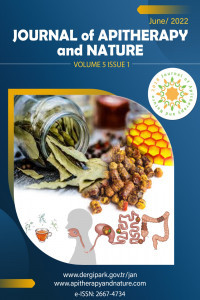Flavonoids Constituents of Algeria Propolis
Flavonoids Constituents of Algeria Propolis
___
- 1. Piccinelli AL, Mencherini T, Celano R, Mouhoubi Z, Tamendjari A, Aquino RP, Rastrelli L (2013) Chemical Composition and Antioxidant Activity of Algerian Propolis. Journal of Agricultural and Food Chemistry. 61: 5080−5088.
- 2. Graikou K, Popova M, Gortzi. O, Bankova V, Chinou I (2016) Characterization and biological evaluation of selected Mediterranean propolis samples. Is it a new type?. LWT - Food Science and Technology 65: 261-267.
- 3. Velikova M, Vassya Bankova V, Sorkunb K, Houcinec S, Tsvetkovad I, Kujumgiev A (2000) Propolis from the Mediterranean Region: Chemical Composition and Antimicrobial Activity. Z. Naturforsch : 55c, 790-793.
- Yayın Aralığı: Yılda 2 Sayı
- Başlangıç: 2018
- Yayıncı: Oktay YILDIZ
Chemical Profile of Greek Arbutus unedo Honey – Biological Properties
αrgyrο ANDREOU, Ioanna CHINOU, Konstantia GRAIKOU
Determination of Phenolic Acids in Raw Propolis Using Near Infrared Spectroscopy
Ana María VIVAR-QUINTANA, İsabel REVILLA, María İnmaculada GONZÁLEZ-MARTÍN, Eddy Valentín BETANCES-SALCEDO
Antioxidant Activities of Propolis from Aragón (Spain)
M. Teresa SANCHO, Sandra M. OSÉS, Andrea RODRÍGUEZ-FERNÁNDEZ, Miguel A. FERNÁNDEZ-MUIÑO, Consuelo PÉREZ-ARQUILLUÉ, Regina LÁZARO, Susana BAYARRI
A New Approach to Propolis Extraction
Saban KESKIN, Merve KESKIN, Sevgi KOLAYLI
Zaccaria VINCENZO, Galeotti FABIO, Fachini ALFREDO, Passarella PAOLO, Daglia MARIA, Volpi NICOLA
Chemical Profile and Botanical Origin of Stingless Bee Propolis from Thailand and Indonesia
ARC (Apiceutical Research Centre): Exploring a New Generation of Medicines from the Beehive
The Influence of Propolis on Liver Pathology in Broilers
Maja MISKULIN, Ivana KLARIC, Matija DOMACINOVIC, Berislav PRAKATUR, Albina DUMIC, Daniela Cacic KENJERIC, İvan MISKULIN
Propolis: A Natural Product – Great Potential as a Medicine
Antituberculosis Activity of Propolis
Jarosław WIDELSKI, Joanna GOLUS, Piotr OKIŃCZYC, Rafał SAWICKI, Grażyna GINALSKA, Tomasz MROCZEK, Zuriyadda SAKIPOVA, İoanna CHINOU, Krystyna SKALICKA-WOŹNIAK
